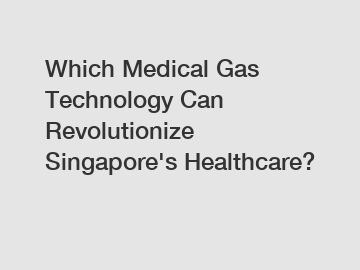Which Medical Gas Technology Can Revolutionize Singapore's Healthcare?
Which Medical Gas Technology Can Revolutionize Singapore's Healthcare?
Singapore's healthcare system has always been at the forefront of innovation and advancement. With the increasing demand for quality healthcare and the need to improve patient outcomes, medical gas technology has emerged as a game-changer in the industry. This article explores the potential of various medical gas technologies and how they can revolutionize Singapore's healthcare system.
1. Nitrous Oxide: Enhancing Anesthesia and Pain Management.

Nitrous oxide, commonly known as laughing gas, has been used in dentistry and various surgical procedures for many years. Its ability to provide analgesia and conscious sedation makes it a valuable tool in anesthesia and pain management. By utilizing nitrous oxide, healthcare providers can offer patients a more comfortable and pain-free experience during medical procedures.
2. Oxygen Therapy: Optimizing Respiratory Support.
Oxygen therapy is a widely used medical gas technology that can significantly improve patient outcomes in respiratory conditions. By providing supplemental oxygen, healthcare professionals can optimize respiratory support, especially in patients with chronic obstructive pulmonary disease (COPD), pneumonia, or acute respiratory distress syndrome (ARDS). Oxygen therapy can alleviate symptoms, prevent complications, and enhance overall patient well-being.
3. Medical Air: Enhancing Infection Control Measures.
Medical air, a mixture of compressed air with a higher quality standard, is essential for infection control measures in healthcare facilities. It is primarily used for respiratory support in neonatal intensive care units (NICUs) and operating theaters. Medical air technology plays a critical role in reducing the risk of infections, as it undergoes rigorous filtration to remove impurities and pathogens.
4. Carbon Dioxide: Advancing Minimally Invasive Surgery.
Carbon dioxide (CO2), when used as a medical gas during minimally invasive surgeries, offers several advantages over traditional open surgeries. CO2 gas, when insufflated into the abdominal cavity, creates a clear operating field and helps surgeons visualize and access internal organs more easily. This technique reduces post-operative pain, scarring, and recovery time, enhancing patient comfort and overall surgical outcomes.
5. Medical Vacuum: Facilitating Wound Management.
Medical vacuum technology, also known as negative pressure wound therapy (NPWT), is widely used in the management of complex wounds and chronic ulcers. By creating a controlled vacuum environment, medical suction devices facilitate the removal of excess fluid, debris, and infectious material from wounds. This promotes faster healing, reduces the risk of infection, and promotes better wound closure.
Conclusion:
As technology continues to advance, the role of medical gases in Singapore's healthcare system becomes increasingly vital. Whether it is enhancing anesthesia and pain management, optimizing respiratory support, improving infection control measures, advancing minimally invasive surgery, or facilitating wound management, medical gas technology offers numerous benefits for both healthcare providers and patients alike.
To explore the potential of medical gas technology and its application in Singapore's healthcare system, contact us. Our team of experts can provide valuable insights, guidance, and support to help revolutionize Singapore's healthcare industry.
Contact us to discover how medical gas technology can transform healthcare delivery, improve patient outcomes, and enhance overall well-being. Let us work together to shape the future of Singapore's healthcare system with innovative medical gas technology.
If you are looking for more details, kindly visit nitrous oxide gas supplier, high purity sulfur hexafluoride, sf6 properties and uses.
280
0
0

Comments
All Comments (0)